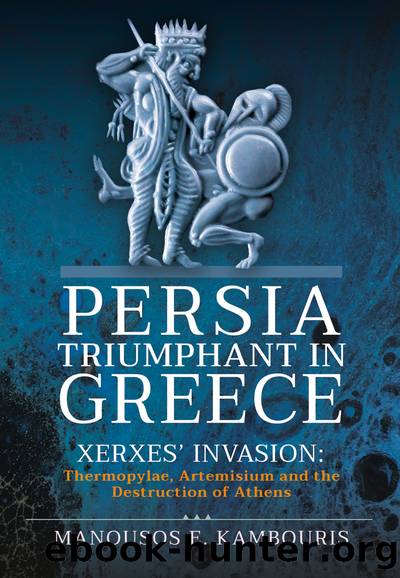Persia Triumphant in Greece by Manousos E Kambouris;

Author:Manousos E Kambouris;
Language: eng
Format: epub
Tags: HISTORY / Military / Ancient
Publisher: Casemate Publishers & Book Distributors, LLC
Chapter 7
Analysis of the Components of the Battle
Tactics â I: Relief by exchanging and rotating units
The main effort of the Allied commander-in-chief, that is Leonidas, was to block the way through the straits by Hoplite phalanx detachments and keep it so. The detachment that drew the first blood remains unidentified. What is of special interest, though, is that individual detachments, or task groups, were up to the task and found adequate means to plug the passage and produce an effective barrier to the enemy assault waves. Leonidas is explicitly mentioned as using and rotating homogenous detachments (Her VII.212,2) as task groups; consequently, they must have been formed by dividing the contributions of some city-states, had they been large, or by grouping other such, when too small.
The smallest were the 80 Mycenaeans, too low to be considered as a task group. The 300 Spartans were definitely able to fight by themselves and this is a comfortable minimum for a 10 to 20m-wide Middle Gate as estimated recently (Rupp 2013); 250 would also have been possible: two shields per metre of front produces a rank of 20 to 40. Thus, 250 men are enough to array at a depth of 12 to 6. Leonidas, though, would have considered psychology and prestige and would not have used detachments smaller than his own elite on their own. Consequently 300â500 shields are the detachment strengths that allow effective defence while keeping maximum homogeneity. The two 500-strong sovereign Arcadian contingents from Mantinea and Tegea would have been the strongest task groups, possibly matched by the Locrian detachment divided into two task groups and the pooled Arcadian contingent of 1,000 men divided to two 500-strong task groups as well.
A better economy could have resulted in 8 or even 10 still reliable task groups of 300-odd shields each from these 3,000 troopers, instead of only 6 groups of 500 shields each. But fighting in complete uniformity and possibly in whole units/subunits of their respective home armies must have made these men much more confident (Rey 2011; Ray 2009); it is important to remember that in phalanx warfare familiarity among closely-packed Hoplites had been a crucial factor (Xen Lac Pol 11,7).
The Thespians and the non-Spartan Lacedaimonians would have formed two 350-strong task groups each, while the Corinthians and the Thebans one task group of 400 shields each. Last, but not least, the Orchomenians, Phliasians and Mycenaeans would have been pooled together to one task group of 400 shields. Thus, if homogeneity and not numerical uniformity had governed Leonidasâ disposition of troops, 14 task groups would have been formed: one mixed, three Lacedaimonian, three Boeotian, two Locrian, four Arcadian, one Corinthian), which were to rotate. The Hoplite phalanx supposedly fought effectively for a short time only, perhaps an hour or so (Hanson 1991, Sekunda 2000 & 2002). This is not attested in any source; numerous events narrated by Herodotus clearly describe prolonged and bitter fighting between Hoplites and non-Hoplite troops (Her V.119,1 & VI.29,1), while the Athenian feat to fight
Download
This site does not store any files on its server. We only index and link to content provided by other sites. Please contact the content providers to delete copyright contents if any and email us, we'll remove relevant links or contents immediately.
The Daily Stoic by Holiday Ryan & Hanselman Stephen(3235)
The Fate of Rome: Climate, Disease, and the End of an Empire (The Princeton History of the Ancient World) by Kyle Harper(3003)
People of the Earth: An Introduction to World Prehistory by Dr. Brian Fagan & Nadia Durrani(2701)
Ancient Worlds by Michael Scott(2625)
Babylon's Ark by Lawrence Anthony(2620)
The Daily Stoic by Ryan Holiday & Stephen Hanselman(2461)
Foreign Devils on the Silk Road: The Search for the Lost Treasures of Central Asia by Peter Hopkirk(2434)
India's Ancient Past by R.S. Sharma(2416)
MOSES THE EGYPTIAN by Jan Assmann(2373)
The Complete Dead Sea Scrolls in English (7th Edition) (Penguin Classics) by Geza Vermes(2235)
Lost Technologies of Ancient Egypt by Christopher Dunn(2194)
The Earth Chronicles Handbook by Zecharia Sitchin(2180)
24 Hours in Ancient Rome by Philip Matyszak(2050)
Alexander the Great by Philip Freeman(2033)
Aztec by Gary Jennings(1975)
The Nine Waves of Creation by Carl Johan Calleman(1884)
Curse Tablets and Binding Spells from the Ancient World by Gager John G.;(1838)
Before Atlantis by Frank Joseph(1811)
Earthmare: The Lost Book of Wars by Cergat(1790)
